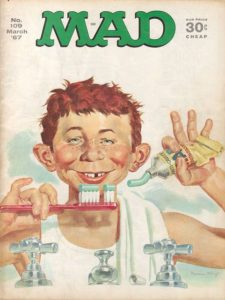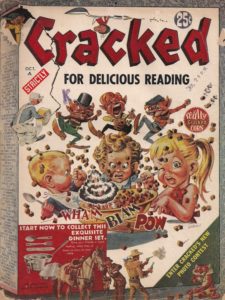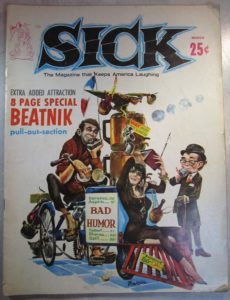
Pity America’s youth prior to 1952.
They had to manufacture their own sick, irreverent, cutting-edge humor. Nowadays, the term for such is “politically incorrect.”
But that year, a strange new comic book called MAD began to be published by EC Comics. EC would be infamous for pushing the envelope a bit too far for 1950’s readership with their horror and science fiction lines, and causing the formation of the Comics Code Authority, which would ensure that kids would only have much blander fare to read for the foreseeable future.
MAD also horrified parents, of course. That was one of the biggest reasons that kids loved it. It specialized in lampooning, and would frequently offer sardonic “apologies” within story lines, begging people not to sue them.
It was great stuff from the get-go, and was also an instant success. Two years after its debut, MAD switched from comic book to magazine format. Those early MAD issues are among some of comicdom’s most sought-after collectibles. But MAD, the magazine, would go on to be a huge influence on the Baby Boomer generation. It would also spawn its imitators.
The first of the pretenders showed up in 1958. Cracked had a simple premise: lowball imitations of westerns, romances, and other popular genres in TV, movies, and on the magazine racks.
While never publicly owning up to imitating MAD, it did so nonetheless, as did the rest of the pretenders.

This is more of a testimony to MAD’s blazing of satire’s trail, rather than the desire to imitate its editorial style. MAD was the first, and it did an incredible job of skewering everything in sight.
Cracked mazagine (it wasn’t until I researched this piece that I learned that it had always been misspelled like that on its cover) managed to carve out an original slot or two on its own. They are the ones who originated the Shut-Ups series. Example: a woman tells her husband “Honey, it’s not nice to avoid someone just because of his color.” “SHUT UP! This guy is a nut!” The man of “color” in question had a bucket of purple paint upside down on his head.
However, Sick magazine simply didn’t stick in my memory banks like the other two. That’s no reflection on the magazine itself, it just that nothing I read (and I read a lot of them) stuck in the permanent brain cells, FWIW.
But despite its inability to stick in my mind, Sick did manage to survive for twenty years, from 1960 to 1980.
The three satirical rags were familiar sights on store magazine racks and also could be spotted stacked up in boys’ bedrooms.
I don’t see any of the three as being a hit with girls. Ladies, is that a true statement?
But we boys loved them. I think it’s safe to say that any 1970’s era class clowns like myself owed much of their material to the Big Three, particularly MAD.

Nowadays, Sick and Cracked are gone (although cracked.com is one of the better hit “wesbites,” and yes, it’s the same folks). MAD is down to four issues a year, but it’s still around.
Today’s class clowns glean much of their material from the interweb. Either that or they watch any of a bazillion shows on a jillion networks.
But we Boomer kids didn’t have that many channels to choose from. And the humor on them was quite tame, compared to what we were looking for. Of course, we couldn’t even envision something like the internet.
So we bought the satire magazines by the bagfuls. And we would hold onto them for years, to be read again and again.
And that’s where many of us got our cynical eye, our willingness to question authority, and our ability to laugh long and hard at the not-meant-to-be-funny antics of the human race.